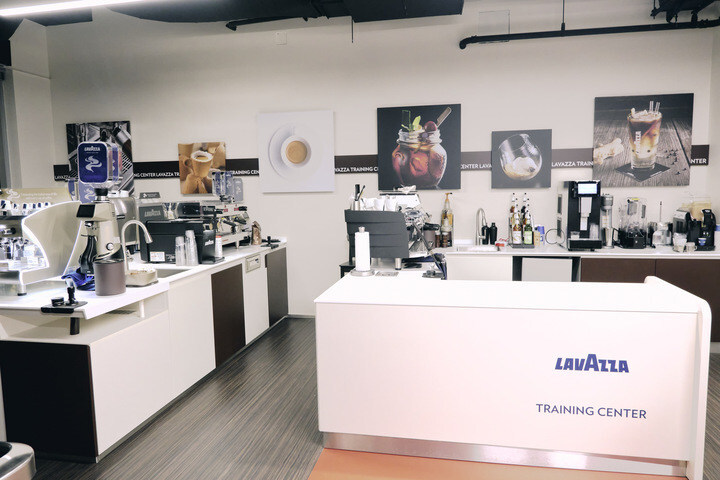Lavazza Expands North American Presence with New State-of-the-Art Training Facility in Dallas

The new Dallas facility is equipped with Lavazza's most advanced espresso, brewing and coffee innovation equipment. It will serve as a hub for industry professionals, Lavazza partners, baristas, distributors and coffee enthusiasts throughout the Southwest, supporting hands-on training, certification, menu development and emerging coffee trends.
"As one of the fastest growing hospitality and culinary markets in the country, Dallas represents a tremendous opportunity for Lavazza," said Daniele Foti, VP of Marketing at Lavazza North America. "Our investment in this new Training Center demonstrates our commitment to the region and to the partners who bring the Lavazza experience to life every day. Dallas is a city of innovation and high standards, and we are excited to deepen our roots here."
The Dallas Training Center embodies Lavazza's global mission to spread coffee culture and serve as a reference point for coffee education throughout the industry. With seven Training Centers in Italy and dozens more worldwide, Lavazza's network is recognized as the largest of its kind and serves culinary professionals, distributors, hospitality leaders and coffee lovers who seek advanced expertise and training. The Dallas Center will play a key role in advancing this mission by offering hands-on workshops, SCA-certified pathways and creative programming that reflect both local market needs and global coffee trends.
"Dallas has an incredible energy and an ever evolving coffee scene," shared Hossam Ashraf, President of Lavazza North America. "We are proud to support our partners with the resources, expertise and tools needed to deliver exceptional coffee experiences. This Center is not only an investment in our business. It is an investment in the people, the talent and the creativity that make this market so dynamic."
Lavazza already partners with some of the most respected hospitality groups and culinary destinations in Dallas. The new Training Center will support and expand relationships with leading accounts that include Rosewood Mansion on Turtle Creek, Coury Hospitality Group, Al Biernat's Steakhouse and Vandelay Hospitality, along with a growing roster of partners across the Dallas and Fort Worth region. Earlier this year, Lavazza also began serving American Airlines, headquartered in Fort Worth, further strengthening the brand's footprint and commitment to the North Texas market. The facility will enable Lavazza to provide closer, more consistent support to these partners and help elevate their coffee programs through continued training and collaboration.
Wetter weather 'perfect' for growing Scottish truffles, scientists say

Climate change is affecting truffle production in mainland Europe – but scientists believe it is creating the ideal conditions for Scotland to grow one of the world's most valuable foods.
Dryer conditions on the continent have led to a decline in production, with some scenarios predicting the collapse of truffle farming in Spain within a generation.
Experts from the University of Stirling are growing truffles on the west coast of Scotland and say the change to wetter summer weather provides the perfect environment for the crop.
They say truffles cultivated on the island of Bute are stronger and more aromatic than those from the continent, making them highly sought-after by chefs.
Professor Paul Thomas, an expert in fungus cultivation at the University of Stirling, planted a small row of hazel trees in 2020 in his garden at Ascog on Bute.
The trees were inoculated with the truffle fungus, which was grown on the roots before they were planted. It can take up to seven years for the truffles to form underground.
They are a similar colour to the soil, so require animal hunters to unearth them by tracing their strong scent.
Traditionally that's been done by pigs, but the handler has to be quick to stop them eating the truffle once it's been located.
Prof Thomas has been training his dog Rue, who sniffed out the first one this summer.
"Truffles in general, across Europe, are having a very tough time as climate change is advancing and primarily that's led by declines in rainfall," he said.
"The models for Scotland, especially the west, are saying slightly wetter summers and maybe slightly milder."
He said there were many ways in which climate change may have a negative impact in Scotland – but that it created "perfect conditions for truffles".
He led a team of researchers who produced a paper in 2019 examining the impact of climate change on European truffle production.
It predicted a decline of between 78% and 100% by the end of the century, depending on the level of global warming.
While most countries have pledged to limit warming to between 1.5 and 2 degrees Celsius, the world is not on track to meet that target.
The average global temperature exceeded the 1.5 degree target for the first time in 2024.
Truffles are understood to have grown in Scotland's ancient woodlands before they were lost centuries ago.
The truffles rely on the roots of the trees for their survival. In the right conditions an orchard could produce up to 20 kilos per hectare.
Truffles currently sell for more than £550 per kilo.
An orchard of around 1,000 trees has been planted on Bute to grow the truffles but it's unlikely to begin producing a crop for another three or four years.
Prof Thomas says that the high value, low volume crop is ideal to be grown on Scotland's islands.
The lengthy wait between planting and cropping means there is not a quick return on the investment – but once they start producing truffles, they can continue to do so for up to 40 years.
In recent years truffles have also been cultivated in other parts of the UK.
Lyndsay Jaimeson is business manager at Mycorrhizal Systems, which has been helping growers wanting to branch out into truffles.
She says Scottish summer truffles a strong, earthy aroma which is popular with chefs.
"A lot of chefs will use them in pasta toppings, make sauces. We have one chef who takes damaged truffles and use them for soufflés," she added.
Source: BBC
Lavazza signs agreement with leading international airline

American Airlines is the latest large-scale airline looking to boost its inflight coffee offering, and has signed a partnership with Lavazza commencing in early 2026.
News of the new partnership follows the likes of fellow United States-based airline Southwest partnering with Peet’s Coffee, and other international airlines like FlySafair and Riyadh Air partnering with local providers Bootlegger and Saudi Coffee Company respectively.
American Airlines travellers will be able to enjoy Lavazza blends across all cabins in flight and at American’s Flagship and Admirals Club lounges.
Americas President at Lavazza Group, Hossam Ashraf, says partnering with a business of the scale of American Airlines will expose more people to Lavazza’s coffee.
“Partnering with American Airlines allows us to bring the true Lavazza experience to travellers around the world,” says Ashraf.
“At Lavazza, we believe in creating moments of pleasure and connection through coffee, and collaborating with a brand that shares our commitment to exceptional experiences helps strengthen our presence and footprint in the market.”
American Airlines is one of the world’s leading global air travel providers, and offers flights to more than 350 destinations in more than 60 countries per day.
Chief Customer Officer Heather Garboden says offering Lavazza coffee is a key component in the company’s goal of improving customer experience.
“We’re proud to team up with this iconic brand to bring a rich, satisfying coffee experience to our customers – whether they’re in the air or relaxing in our lounges,” says Garboden.
“At American, we’re focused on looking at every aspect of the customer experience, and a quality cup of coffee is an important part of that journey.”
Olive Oil Prices in 2025: Trends, Drivers and Outlook
Introduction
Olive oil is both a culinary staple and a traded agricultural commodity. In 2025, the market is experiencing a complex mix of pressures — from harvest yields and weather, to supply chain costs, demand dynamics, and regulatory or trade shifts. Understanding the price movements is essential for producers, traders, wholesalers, and even consumers. In this article, we review the current state of olive oil pricing in 2025, the main factors influencing price changes, regional differences, and expectations for the rest of the year.
Recent Price Trends
- In many Mediterranean-producing countries, olive oil prices have been declining during early to mid-2025.
- For example, in Spain, average extra virgin olive oil (EVOO) prices dropped below €4.00 per kg in early 2025.
- Certified Origins reports that the downward trend continued in May 2025, driven by favorable weather and improved supply across major growing regions (excluding Italy, where stocks are tighter).
- However, markets are showing some stabilization in mid-2025, especially as producers and traders await the outlook for the 2025/26 crop year.
- The International Olive Council’s data indicates that in early July 2025, producer prices in Jaén (Spain) rose by a modest 0.4% week over week.
Thus, the baseline movement in 2025 has been a downward correction from earlier highs, but with signs that the decline may decelerate or even reverse depending on conditions.
Key Drivers of Price Changes
Several intertwined factors are driving these price dynamics:
- Harvest Volume and Weather Conditions
- After a few years of lower yields in some regions (due to drought, disease, or extreme weather), many olive-growing areas saw improved rainfall and agronomic conditions in 2024–2025, contributing to higher forecasted yields.
- Strong yields put downward pressure on prices, especially for bulk and lower-grade oils.
- On the flip side, localized weather risks (e.g. late frosts, heat waves, pests) remain as potential upside threats to supply.
- Stock Levels & Carryover Supply
- Some regions entered 2025 with moderate carryover stocks, which help buffer supply fluctuations.
- However, in places like Italy, stocks are tighter, which constrains how much the price can drop, particularly for premium oils.
- Cost Pressures (Inputs, Labor, Logistics)
- Rising input costs (fertilizer, fuel, equipment) impose upward pressure on producers.
- Logistics, packaging, and transport costs also influence the final delivered price, especially for exporters shipping over long distances.
- Inflationary pressures in many parts of the world continue to create cost squeezes in the supply chain.
- Demand Side Dynamics
- Global demand for olive oil remains relatively steady, supported by consumer awareness of health and Mediterranean diets, and use in foodservice.
- However, when unit prices rise too high, some buyers may switch to cheaper oils (sunflower, canola, etc.).
- Premium and specialty segments (organic, single-origin, cold-pressed) tend to show more price resilience.
- Trade, Tariffs and Regulations
- Export and import tariffs, quality regulations, and certification standards (PDO, PGI) can create premium differentials or barriers.
- Currency fluctuations and trade agreements also impact export-import margins.
- Speculation and Market Sentiment
- Traders’ expectations about the upcoming harvest (2025/26) can influence forward pricing and contract offers.
- If markets expect a weak next crop, prices may firm in advance despite current supply.
- Regional Variation & Quality Differentiation
Prices are not uniform: location and quality matter greatly.
- Spain: A major global producer, Spanish olive oil (especially industrial-grade) has seen sharper declines. Some conventional EVOO in Spain traded below €4.00/kg.
- Italy: Italian EVOO commands a premium in many markets due to branding, quality reputation, and limited volume. Its prices have been more resistant to decline.
- Greece: Markets in Greece are stabilizing after sharp early declines. Some EVOO prices in Greece are reported around €3.90–€4.20/kg (depending on region & quality).
- Tunisia, Turkey, North Africa: These non-EU producers also influence global supply. Tunisia is anticipating strong harvests, which could increase competitive pressure.
Quality distinctions — extra virgin, organic, single variety, early harvest — carry significant premiums, and these segments often deviate from bulk market trends.
Why Coffee Prices Are Soaring in 2025
7. Trade Policies, Tariffs & Geopolitical Risks